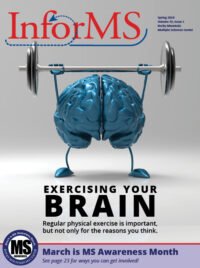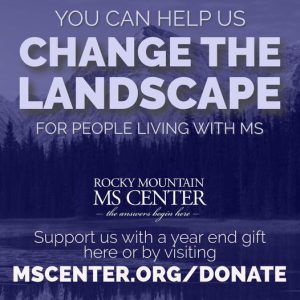Read about Jane, Stephanie and Katie’s personal experience with exercise and increasing their activity levels.
Jane
64 years old, diagnosed at 59 — Denver, Colorado | Like so many others, when I was diagnosed I was having increasing heat sensitivity, balance issues, and extreme fatigue that was limiting the amount of activity I could endure. My limbs always felt like they had heavy weights strapped to them and I was struggling to pick up my feet and lift my arms. I was not using a cane or walker, but had become afraid that I was slowly losing my ability to walk independently.
These weren’t the only concerns, but they were some of the main ones that were affecting my ability to work. As I seemingly dragged myself through the next year, I found I was losing more of my abilities and after a fall was referred to Physical Therapy. I struggled to do traditional exercises in the gym and then one day the therapist suggested I try some water exercise in one of our sessions.
At first I was concerned that the water would be too cold. But I found it surprisingly mild, and when I felt the relative weightlessness of my body I was elated! All of a sudden, I felt like I had boundless energy and strength. My therapist then had to caution me to not overdo it or I would have to deal with something like rebound fatigue when I got out. I settled down and I had the best workout I’d had in years. Yes, I was tired afterward, but I finally felt muscles I hadn’t felt in such a long time.
That’s how the story began for me and then I finally found my way to the exercise group led by Michele Harrison, Hydrotherapy Coordinator for the Rocky Mountain MS Center. I live clear across town from the pools where the sessions are held, yet I would have traveled farther to get the opportunity to work with Michele. Through teaching me specific exercises and how to use equipment designed to address my particular issues, along with the importance of stretching, she has helped me to strengthen my muscles and increase my flexibility. My balance and energy level have improved as well as my mood, and I have even made new friends. I am certain that with Michele coaching me I was able to keep working, which was my main goal.
My husband began coming with me after I fell in November of 2016. I couldn’t drive and needed more individual help in the pool. He was taught how to help me stretch and exercise. He found that he liked being in the pool and being with the other people as well as learning about the equipment we use. He enjoyed it so much in fact that as I got better he kept coming as a volunteer!
I’m not saying that hydrotherapy is a cure-all for MS. I am saying that for me, it has helped me get through some of the most difficult challenges of the past four years. I have fallen several times during that time and yet I was able to rehab a chest contusion and another time a broken ankle and still get back to work. I no longer work at that same job and I use a walker now, but I was able to continue to work without walking aides right up until last Spring. I firmly believe that I am able to keep going mentally and physically because of the benefits of exercise and that hydrotherapy was the way to go for me.
Stephanie
45 years old, diagnosed at 31 — Parker, Colorado |
I view exercise as a medication prescribed by my doctor that I must take in some form every day. It’s that serious and important to my body and brain. My weekly fitness goals are: 45 minutes of strength training during three days (not in a row), 180 minutes of cardio, balance exercises during two days, and 70,000 steps (10,000 steps per day). I religiously use my Fitbit to record my time exercising and to keep me accountable to my goals.
My husband and I started specialized strength training sessions with a trainer at our local recreation center five years ago. It was hard not to quit for the first year but working out became a habit. Now, I schedule strength training sessions in my calendar as repeating events to maintain this habit. While I workout my entire body, I emphasize strengthening my core. Having a strong core is key to maintaining my balance.
Having good balance makes it possible for me to do the active things I love and to keep up with my children. I received balance exercises from a physical therapist and specialized trainer. I did the exercises daily until they became easy for me. Now, I schedule balance exercises in my calendar and do them twice per week for my maintenance plan.
Running outside is how I get my cardio. When I first started running over a year ago, 180 minutes running weekly seemed an overly lofty goal but I kept at it. Now, I run 30 to 80 minutes at a time without stopping and run up hills or whatever is in front of me. If I miss a day running, I don’t beat myself up about it and make sure to go the next day. Every day I run, I easily complete my 10,000 daily steps and sometimes accomplish 20,000 steps.
I always look for ways to be active. I try to walk or run places instead of taking my car like taking my son to school and picking him up from school. I like exploring so I find new places to run frequently and this causes me to test my limits and run farther. I plan things for my family that are active.
I use several adaptations in exercise. I started strength training with a specialized trainer who helped me do exercises appropriate for my MS. Doing balance exercises and having a strong core help me maintain my balance while exercising and being active. I listen to my footsteps while running to make sure I’m not dragging my feet. Also, I pay attention to my body and rest if I need to.
Being a runner for more than a year is an accomplishment I’m proud of. Also, I compete in 5Ks to have attainable running goals that keep me motivated. My goal is to finish in 30 minutes, which I’ve done. I’m proud that I’m now able to play sports with my kids.
After I had been running for a few months while continuing strength training, I noticed that I had more energy, my legs were less spastic, I’m sick less, I have less brain fog, and I can keep up with my kids.
Pain was a huge hurdle in the beginning of my exercise program. I changed my relationship with pain because exercise is painful! I decided that pain is one of the costs I have to pay to live the life I want to. Pain motivates me to keep moving now. It is more painful not to move so I move.
Time is a challenge because it takes a lot of time to prepare myself to exercise, exercise, cool down after exercise. It’s really a part time job. When I’m squeezed for time I take the stairs instead of the elevator and walk or run to do small errands. I make sure that I do some form of physical activity daily.
Fear of falling was something that I had to overcome a little bit before I started running. I thought I would trip over my own feet and fall flat on my face. I started slowly and increased my pace and distance as I felt comfortable. I don’t use earbuds so I can hear my footsteps and hear if I’m dragging my feet. I haven’t fallen so far, which builds confidence too.
My advice is to make attainable goals for yourself. Start a bit at a time and keep building. Keep track of what you do so you can see your progress. Don’t get discouraged if you miss a day. Go for it tomorrow. Make sure to stay hydrated by drinking plenty of water before, during, and after you exercise. Don’t forget to breathe! Breathe deeply in through your nose and out through your mouth. Breathing correctly makes exercise possible.
Katie
33 years old, diagnosed at 32 — Aurora, Colorado | I look like a healthy 33 year old, so people assume that I am. When, in reality, I’m dealing with a lot — I’ve dealt with emotional problems with my MS diagnosis and cognitive challenges. People see you, think you look healthy, and assume there’s nothing wrong with you.
Now that I’m dealing with MS, I’ve adjusted from hot yoga to normal yoga. During hot yoga, I started experiencing dizziness and would need to leave the room. The last thing I wanted was to go to a yoga class and then be sick for three days. Now, I always tell the instructor that I have MS before the class begins, and that I’ll be near the door so that if I get to too warm I will be able to step out of the studio more easily. So gauging and listening to myself, having those conversations ahead of time, and not trying to push things too hard has been very helpful.
I’ve been very active my whole life — I’ve always been a runner and used to play high-level soccer. When it’s a beautiful day out, I love to run outside. When I’m running distances more than three miles, I have to run outside, because I’ve had issues with overheating when trying to run in a gym.
When I do work out inside, I’ve learned that it’s very important for me to gauge my body temperature. I really try to stay in tune with how I’m feeling that day: What’s my fatigue level? What’s my energy level? I listen to my body. I’ll start out using the elliptical machine to see how I’m feeling and then if that works okay, I move to the treadmill and try that.
It’s been critical for me to address some of the mental health challenges that I’ve faced. When I had my initial exacerbation, I didn’t know if I was going to have the use of my left hand again — and that was scary. I was adjusting, figuring it out, and navigating the uncertainty of it all. Most people don’t know how common depression is with MS. My emotions have been a rollercoaster since my diagnosis, so I’ve sought out counseling and I’m really working on my mental health. Support groups and the MS Young Professionals Network have been very helpful for me — connecting with other people to meet up and socialize and share successes and challenges. Running, biking, yoga, getting outside, and eating healthfully have also really helped me to boost my mental health.
Throughout this issue, we’re sharing personal stories of real people who’ve made exercise a part of their lives, including several participants in the Rocky Mountain MS Center’s MS Wellness Pilot Program. With generous support from the Jimmie Heuga Foundation, the Wellness Pilot Program was conducted in 2017-18 and focused on making wellness a part of overall MS treatment. Stay tuned to RMMSC communications for more information on what’s next with the MS Wellness Program.
[su_load_module id=”314″]



